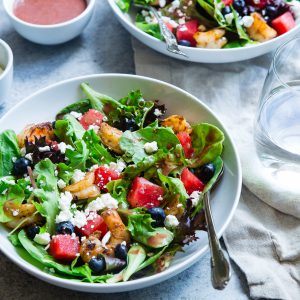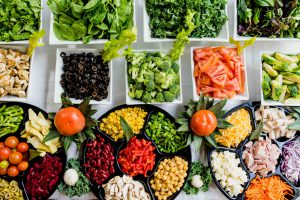 What makes a salad healthy? Of course, it’s the healthful ingredients from the lettuce to the dressing and everything in between. While there is no “one recipe” for salad, it typically features basic ingredients such as lettuce, tomatoes, carrots and dressing. However, in recent years, salads have taken on a life of their own. They have become much more than an appetizer when prepared with healthful ingredients in appropriate amounts. Salads are popular entrées for people who want to manage their weight and increase consumption of fresh vegetables and fruits. Healthy salads typically contain a variety of low-fat, nutrient-rich foods such as
What makes a salad healthy? Of course, it’s the healthful ingredients from the lettuce to the dressing and everything in between. While there is no “one recipe” for salad, it typically features basic ingredients such as lettuce, tomatoes, carrots and dressing. However, in recent years, salads have taken on a life of their own. They have become much more than an appetizer when prepared with healthful ingredients in appropriate amounts. Salads are popular entrées for people who want to manage their weight and increase consumption of fresh vegetables and fruits. Healthy salads typically contain a variety of low-fat, nutrient-rich foods such as
dark-colored lettuce, vegetables, fruits and protein sources such as meat, poultry, seafood, legumes, nuts or seeds topped with low-fat, low-sodium dressing.
 Selecting nutrient-rich lettuce is the first step to building a healthy salad. However, not all lettuce is “nutritionally” equal. The nutritional value of lettuce varies based on the type. In general, lettuce supplies few calories with very small amounts of carbohydrate, protein and dietary fiber. The key nutrients are folate, potassium, vitamins A and K and water. The main characteristic when selecting nutrient-rich lettuce is the color: the darker the better. Dark green lettuce is rich in vitamin A. Actually, it is rich in beta-carotene, which converts to vitamin A in the body. Click here for suggestions from the UF/IFAS Extension Service on making healthy salads.
Selecting nutrient-rich lettuce is the first step to building a healthy salad. However, not all lettuce is “nutritionally” equal. The nutritional value of lettuce varies based on the type. In general, lettuce supplies few calories with very small amounts of carbohydrate, protein and dietary fiber. The key nutrients are folate, potassium, vitamins A and K and water. The main characteristic when selecting nutrient-rich lettuce is the color: the darker the better. Dark green lettuce is rich in vitamin A. Actually, it is rich in beta-carotene, which converts to vitamin A in the body. Click here for suggestions from the UF/IFAS Extension Service on making healthy salads.
Selection and Storage
Select lettuce that is fresh with the outer leaves intact and clean. Avoid lettuce that is wilted, slimy or has black spots. Store unwashed lettuce in a perforated plastic bag in the vegetable crisper of the refrigerator at 40°F or below and use within a few days.
Clean
Wash all produce, whether grown conventionally or organically, thoroughly under cool running tap water. It is not recommended to wash produce with soap, detergent or commercial produce washes. Lettuce leaves should be patted dry with a clean paper towel to remove excess water and prevent wilting.
Nutritional information for select lettuce varieties:
one-cup raw, shredded or chopped
| Lettuce | Calories | Fiber grams | Potassium milligrams | Vitamin A RAEs* |
Vitamin K micrograms | Folate micrograms |
| Butter head | 7 | 0.6 | 131 | 91 | 56 | 40 |
| Green- leaf | 5 | 0.5 | 70 | 133 | 46 | 14 |
| Iceberg | 8 | 0.7 | 80 | 14 | 14 | 17 |
| Red leaf | 4 | 0.3 | 52 | 105 | 39 | 10 |
| Romaine | 8 | 1.0 | 116 | 205 | 48 | 64 |
* Retinol Activity Equivalents – RAEs
Nutrition Information Reference: United States Department of Agriculture Nutrient Database
 0
0
